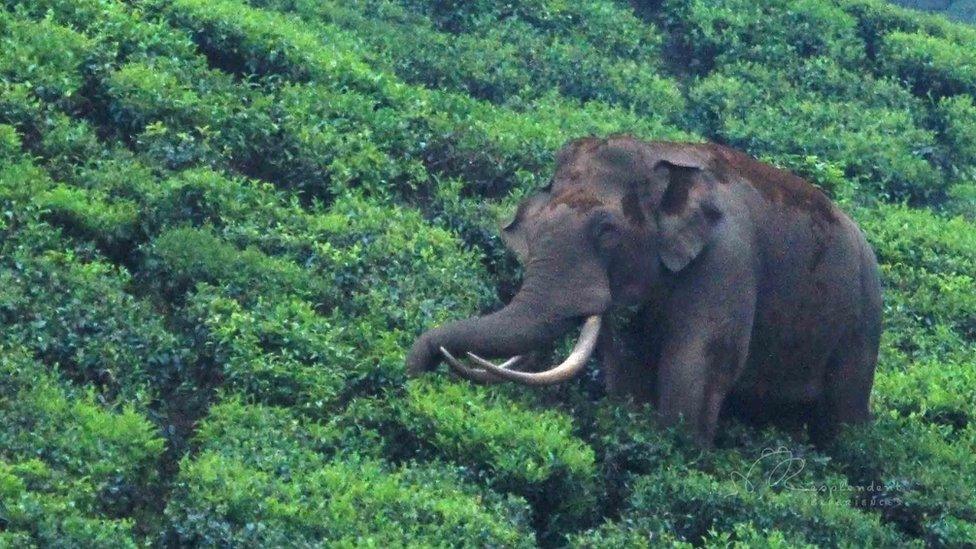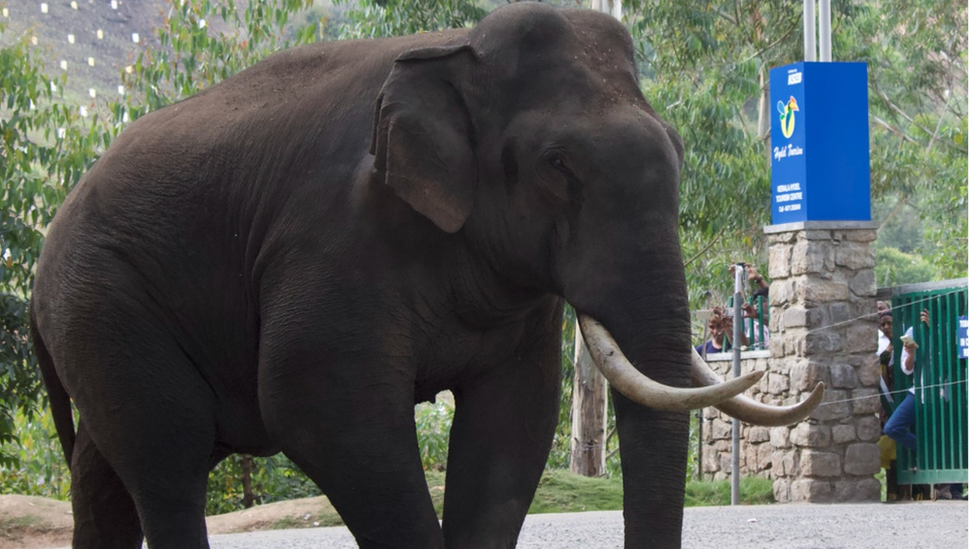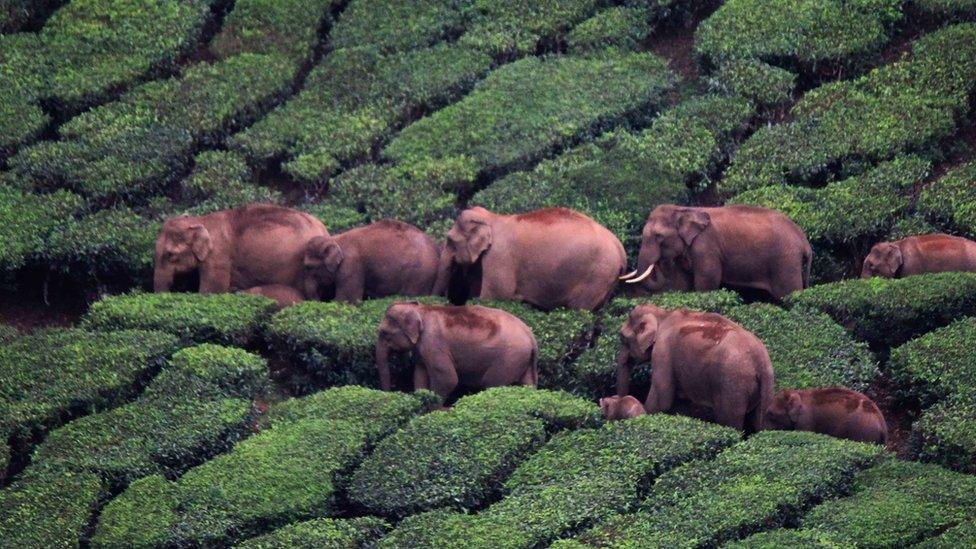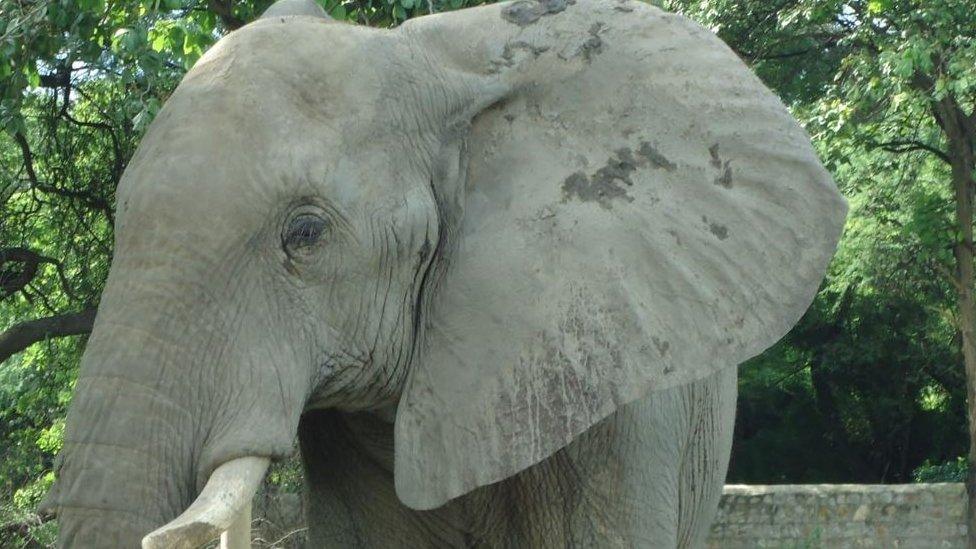Padayappa: The friendly India elephant whose fame is a curse
- Published

Wild Indian elephant Padayappa is a local hero in Kerala state
Padayappa is an iconic figure in the southern Indian state of Kerala.
The wild elephant, who lives in the state's lush jungles, is known for his flappy ears, massive tusks and friendly ways.
Padayappa's bond with the people of Kerala goes back decades.
Locals in the town of Munnar, near Padayappa's habitat, call him a "gentle giant" who has never hurt anyone, even though he occasionally pilfers food from their homes and farms at night.
His name comes from the 1999 blockbuster movie Padayappa - a swashbuckling tale of betrayal and family honour - starring superstar Rajinikanth.
Padayappa is also a favourite with tourists, many of whom flock to the hilly town to click photographs of the animal.
But over the past few months, the elephant, who is believed to be 50 years old, has developed a bit of a bad boy image.
Locals say that Padayappa, who would once take leisurely strolls in and around the town, has become noticeably irritable around humans.
In January, reports say, the elephant broke, external the windshields of a truck and a tuk-tuk before running amok in a nearby butter bean farm and eating the crop.
The incident was the latest in a series of episodes where Padayappa displayed violent tendencies, sparking concerns about changes in his behaviour.
Some attribute Padayappa's outbursts to him being in musth - a period during which reproductive hormones surge in mature male elephants, making them prone to aggression.

Padayappa is often seen strolling around Munnar, a small hilly town in Kerala
However, experts say that it's excessive human intervention in Padayappa's natural habitat that's causing problems.
"Even elephants in musth do not get violent unless they are provoked," says Dr PS Easa, a member of the Asian Elephant Specialist Group of the International Union for Conservation of Nature.
He adds that Padayappa needs large "disturbance-free habitats" where he can roam and feed at will.
"Elephant habitats need to be protected and steps should be taken to prevent their fragmentation," Dr Easa says.
Human-animal conflicts are often reported in India as shrinking natural habitats force wild animals to enter human settlements in search of food and shelter. In Kerala itself, rogue tuskers separated from their herds have killed 105 people, external between 2018 and 2022.
In January, after state forest officials captured alive a rogue elephant in Palakkad district, they found that its body had more than a dozen pellet marks, possibly from air guns. Locals claimed that the elephant had been wreaking havoc in their village for months and alleged it had even killed a man.
Padayappa's human neighbours say he is different.
Lalita Mani, who lives in a town near Munnar, says Padayappa has visited her house at least thrice and eaten bananas and bamboo.
Once, she says, Padayappa uprooted ten banana trees from her field and "stood there and took his time to eat the fruit before slowly walking away".
Yet, Ms Mani has nothing but affection for him. "The poor creature comes when he feels hungry. He does no harm," she says.
Padayappa is mostly found roaming in and around the forests of Munnar, although he makes occasional detours to other areas.
Hadlee Renjith, a wildlife photographer who has been tracking Padayappa's movements since 2014, describes him as a majestic animal whose left tusk "is slightly longer than the right one".
Mr Renjith sees the pachyderm at least once in two months. "I film from a safe distance. He ignores me, but appears to be posing for the photograph," he says, adding that Padayappa is the "most human-friendly" wild elephant he has ever seen.
Stories about Padayappa's mischievous but friendly demeanour have made him a local celebrity.
If he is crossing the road, locals stop their vehicles to let him pass. Tourists come looking for him to click selfies. And shopkeepers say they don't even mind the elephant occasionally raiding their stores, as he brings a lot of customers.
"Padayappa is our brand ambassador," says Vinod Vattekkat, vice-president of Showcase Munnar, an initiative that promotes tourism in the region.

Tourists flock to click selfies with Padayappa
That is why the sudden change in Padayappa's behaviour has surprised many people.
In December, Padayappa reportedly trampled on two bikes, external when some tourists tried to block his way. The men were apparently trying to take a photograph of the elephant.
In April, he charged at a bus, external which had around 50 passengers, and damaged its windshield.
Padayappa's fans believe that his outbursts are triggered by humans who want to "annoy" him.
Mr Renjith recalls an incident from last year, where Padayappa was trying to cross a road. A bus driver tried to speed past him instead of waiting.
"Padayappa didn't like it. He thrust his trunk into the vehicle and its windshield broke," says the photographer, adding that the elephant immediately disengaged from the vehicle.

Padayappa (tusks visible) with a herd of elephants
Suresh Palraj, who works at a plantation in Munnar, says tuk-tuk and tractor drivers often provoke the elephant by continuously honking at him.
In December, forest authorities filed a case against a man, external who tried to scare Padayappa away from his tea garden by blaring his horn.
Experts say that tourism picking up in the scenic region, after a pandemic-induced lull, could also have irritated the elephant.
"There is nothing unusual about Padayappa's behaviour. All wild elephants get irritable when you get close to them and try to click selfies," says wildlife expert James Zachariah, who has observed Padayappa for two decades.
"They charge because they feel threatened. But that does not necessarily mean they will attack you," he says, adding that he thinks a lot of the discourse around Padayappa's behaviour is "exaggerated".
Since Padayappa's actions started making headlines in India, he has also received a lot of media attention.
One newspaper editorial reminded, external its readers that Padayappa was "always an elephant in the wild - to be treated with respect and caution".

Read more India stories from the BBC:

- Published3 August 2022
- Published31 January 2022
